Compact Ultra-Wideband Phase Inverter Using Microstrip-CPW-Slotline Transitions
Abstract
1. Introduction
2. Design of the Phase Inverter
3. Implementation and Measurements
4. Conclusions
Author Contributions
Funding
Acknowledgments
Conflicts of Interest
References
- Hagiwara, K.; Arai, H. Wideband unbalanced fed 180-degree phase shifter using phase inverter. In Proceedings of the 2013 IEEE International Workshop on Electromagnetics, Applications and Student Innovation Competition, Kowloon, China, 1–3 August 2013; 76–77. [Google Scholar] [CrossRef]
- Wong, K.W.; Chiu, L.; Member, S.; Xue, Q.; Member, S. Wideband Parallel-Strip Bandpass Filter Using Phase Inverter. IEEE Microw. Wirel. Compon. Lett. 2008, 18, 503–505. [Google Scholar] [CrossRef]
- Wu, T.W.K. Size-reduction and band-broadening design technique of uniplanar hybrid ring coupler using phase inverter for M(H)MIC’s. IEEE Trans. Microw. Theory Tech. 1999, 47, 198–206. [Google Scholar] [CrossRef]
- Kim, Y.-G.; Song, S.-Y.; Kim, K.W. A Compact Wideband Ring Coupler Utilizing a Pair of Transitions for Phase Inversion. IEEE Microw. Wirel. Compon. Lett. 2011, 21, 25–27. [Google Scholar] [CrossRef]
- Mo, T.T.; Xue, Q.; Chan, C.H. A broadband compact microstrip rat-race hybrid using a novel CPW inverter. IEEE Trans. Microw. Theory Tech. 2007, 55, 161–166. [Google Scholar] [CrossRef]
- Hasan, M.N.; Seo, M. High-gain 2 × 2 UWB antenna array with integrated phase inverter. Electron. Lett. 2018, 54, 177–187. [Google Scholar] [CrossRef]
- Riaan, F.; Johan, J. A broadband 180° hybrid ring coupler using a microstrip-to-slotline inverter. Microw. Opt. Technol. Lett. 2015, 57, 2164–2168. [Google Scholar] [CrossRef]
- Eldek, A.A. Wideband 180° phase shifter using Microstrip-CPW-microstrip transition. Prog. Electromagn. Res. B 2008, 2, 177–187. [Google Scholar] [CrossRef]
- Huang, J.; Wang, Q.; Li, Z.; Yang, L. Novel method for millimeter wave phase shifter design using loaded transmission line. Asia Pac. Microw. Conf. Proc. APMC 2017, 7–10. [Google Scholar] [CrossRef]
- Guo, L.; Zhu, H.; Abbosh, A. Wideband Phase Shifter with Wide Phase Range Using Parallel Coupled Lines and L-Shaped Networks. IEEE Microw. Wirel. Compon. Lett. 2016, 26, 592–594. [Google Scholar] [CrossRef]
- Yoon, H.J.; Min, B.W. Wideband 180° phase shifter using parallel-coupled three-line. IEEE Microw. Wirel. Compon. Lett. 2019, 29, 89–91. [Google Scholar] [CrossRef]
- Peng, H.; Zhao, F.; Tatu, S.O.; Dong, J.; Yang, T. Empty substrate-integrated waveguide phase inverter in millimetre-wave band application. Electron. Lett. 2020, 56, 382–385. [Google Scholar] [CrossRef]
- Tebache, S.; Ghanem, F.; Belouchrani, A.; Mansoul, A. Novel flowchart design of frequency independent 180° phase shifters. Microw. Opt. Technol. Lett. 2019, 61, 136–140. [Google Scholar] [CrossRef]
- Kim, Y.G.; Song, S.Y.; Kim, K.W. A pair of ultra-wideband planar transitions for phase inversion applications. IEEE Microw. Wirel. Compon. Lett. 2010, 20, 492–494. [Google Scholar] [CrossRef]
- Gupta, K.C.; Garg, R.; Bahl, I.; Bhartia, P. Microstrip Lines and Slotlines; Artech House: London, UK, 1996. [Google Scholar]
- Guo, Z.; Yang, T. Novel compact ultra-wideband bandpass filter based on vialess vertical CPW/microstrip transitions. Electron. Lett. 2017, 53, 1258–1260. [Google Scholar] [CrossRef]
- Lee, G.H.; Mohyuddin, W.; Choi, H.C.; Kim, K.W. Asymmetric Ultra-Wideband Microstrip-to-Coplanar Stripline Transition. IEEE Microw. Wirel. Compon. Lett. 2018, 28, 386–388. [Google Scholar] [CrossRef]
- Lee, J.S.; Lee, G.H.; Mohyuddin, W.; Choi, H.C.; Kim, K.W. Design of an ultra-wideband microstrip-to-slotline transition on low-permittivity substrate. Electronics 2020, 9, 1–14. [Google Scholar] [CrossRef]
- Lee, G.H.; Kim, D.H.; Mohyuddin, W.; Kumar, S.; Choi, H.C.; Kim, K.W. Design of an Ultra-wideband Coplanar Strip-to-Parallel Stripline Transition Using an Analytical Model Based on Conformal Mapping. Microw. Opt. Technol. Lett. 2020. [Google Scholar] [CrossRef]
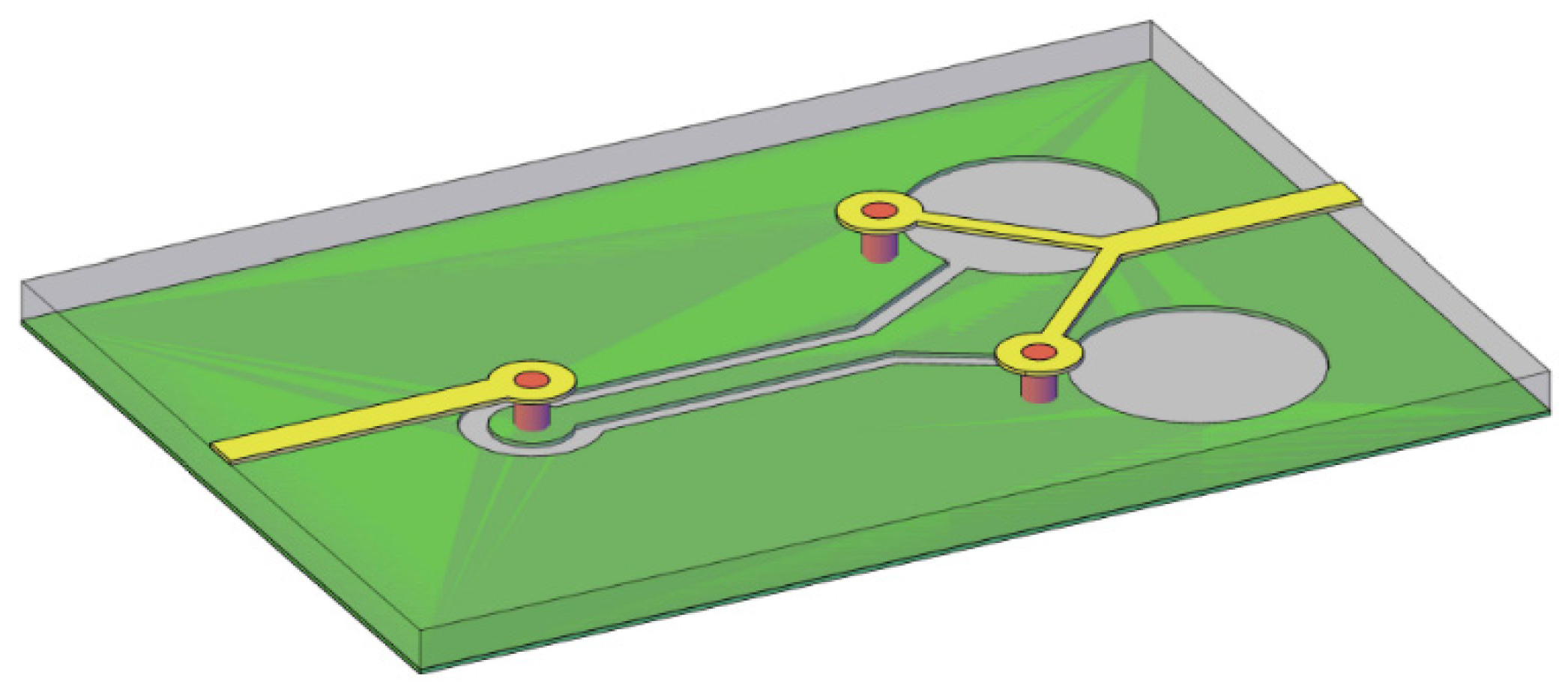
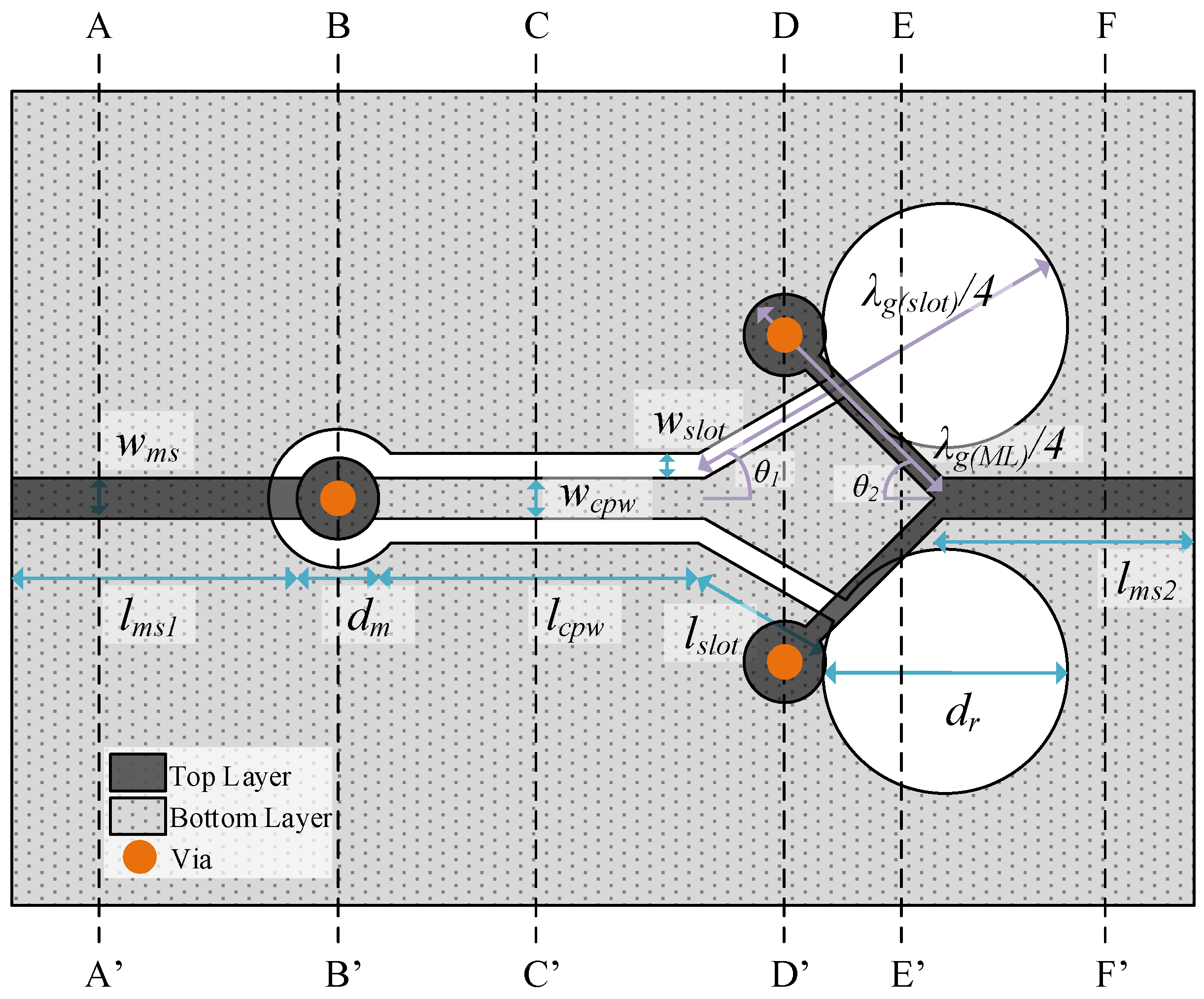
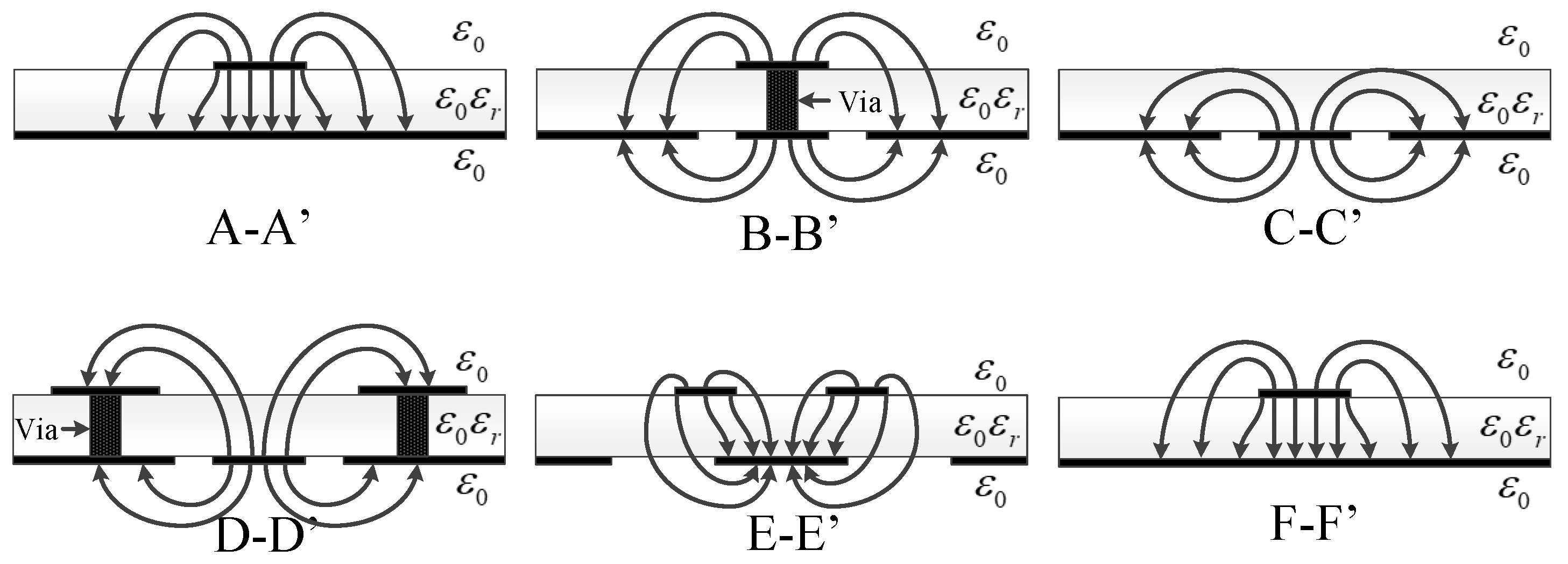

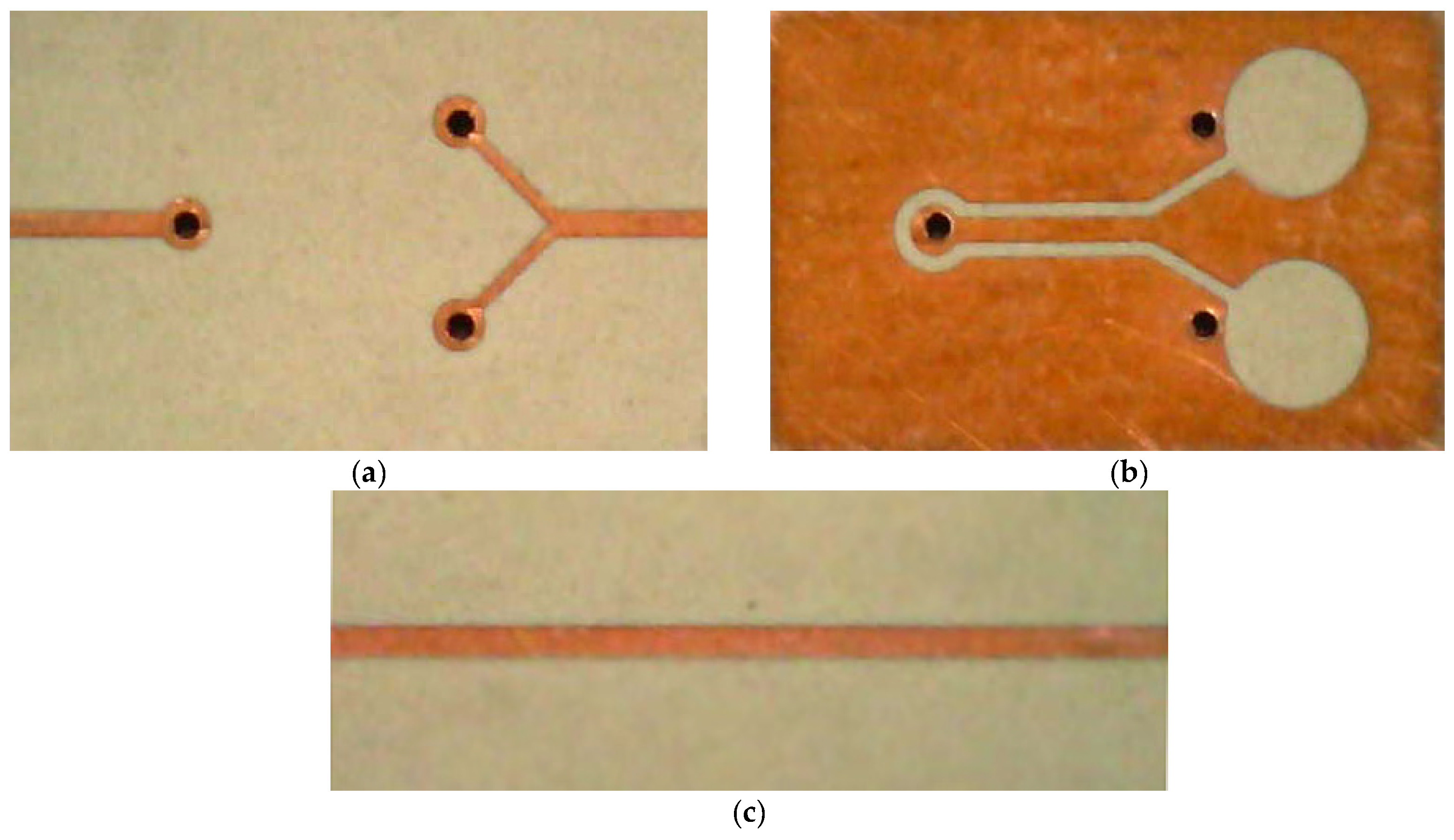

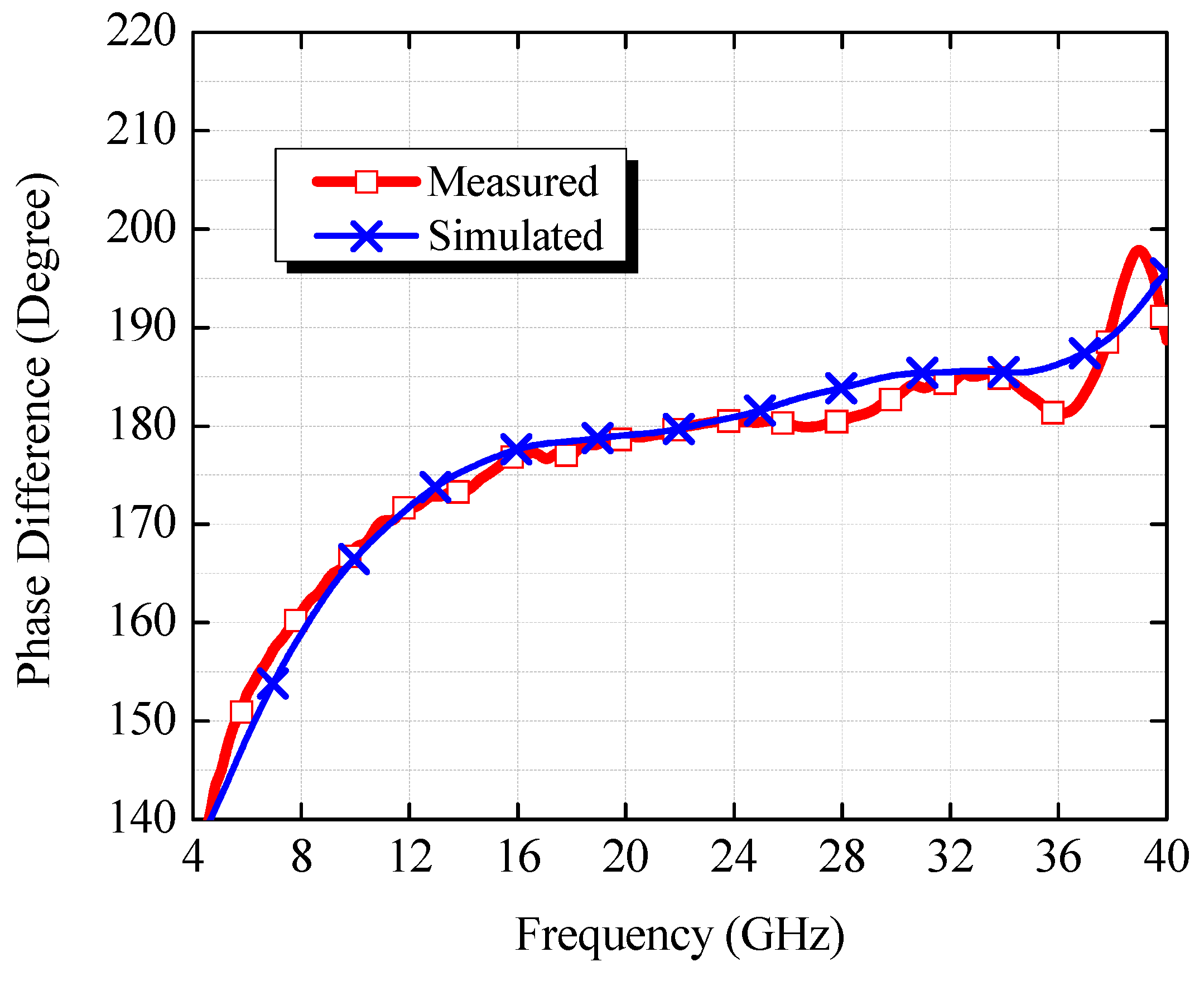
| A-A’ | B-B’ | C-C’ | D-D’ | E-E’ | F-F’ |
|---|---|---|---|---|---|
| 6.73 | 4.20 | 5.09 | 3.20 | 6.33 | 6.73 |
| Ref. | Max PD (°) | IL (dB) | RL (dB) | BW (%) | FR (GHz) |
|---|---|---|---|---|---|
| [5] | ±25 | N/A | >10 | 120 | 1–4 |
| [9] | ±4.6 | <1.48 | >10 | 28.01 | 24.4–32.35 |
| [10] | ±8 | <1.3 | >10 | 100 | 1–3 |
| [11] | 5 | <0.5 | >15 | 83.9 | 1.14–2.79 |
| [12] | ±2.9 | <2.66 | >12.7 | 42.42 | 26–40 |
| [13] | ±3.6 | <2.1 | >10 | 142.8 | 2–12 |
| [14] | ±5 | <1.8 | >10 | 169 | 2.1–25 |
| TW | ±5 | <2 | >10 | 98.04 | 13–38 |
Publisher’s Note: MDPI stays neutral with regard to jurisdictional claims in published maps and institutional affiliations. |
© 2021 by the authors. Licensee MDPI, Basel, Switzerland. This article is an open access article distributed under the terms and conditions of the Creative Commons Attribution (CC BY) license (http://creativecommons.org/licenses/by/4.0/).
Share and Cite
Mohyuddin, W.; Lee, G.H.; Woo, D.S.; Choi, H.C.; Kim, K.W. Compact Ultra-Wideband Phase Inverter Using Microstrip-CPW-Slotline Transitions. Electronics 2021, 10, 252. https://doi.org/10.3390/electronics10030252
Mohyuddin W, Lee GH, Woo DS, Choi HC, Kim KW. Compact Ultra-Wideband Phase Inverter Using Microstrip-CPW-Slotline Transitions. Electronics. 2021; 10(3):252. https://doi.org/10.3390/electronics10030252
Chicago/Turabian StyleMohyuddin, Wahab, Gwan Hui Lee, Dong Sik Woo, Hyun Chul Choi, and Kang Wook Kim. 2021. "Compact Ultra-Wideband Phase Inverter Using Microstrip-CPW-Slotline Transitions" Electronics 10, no. 3: 252. https://doi.org/10.3390/electronics10030252
APA StyleMohyuddin, W., Lee, G. H., Woo, D. S., Choi, H. C., & Kim, K. W. (2021). Compact Ultra-Wideband Phase Inverter Using Microstrip-CPW-Slotline Transitions. Electronics, 10(3), 252. https://doi.org/10.3390/electronics10030252







